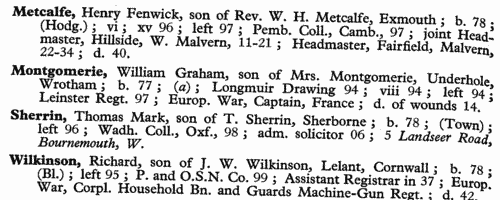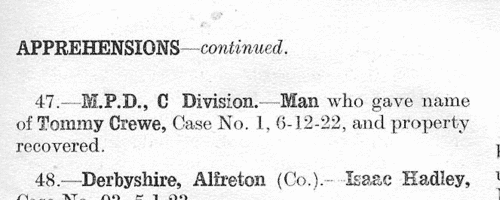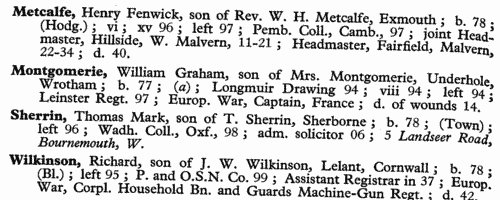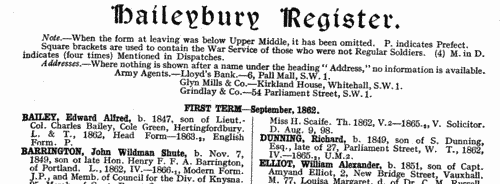Add this eBook to your basket to receive access to all 548 records. Our indexes include entries for the spelling higginson. In the period you have requested, we have the following 548 records (displaying 491 to 500): These sample scans are from the original record. You will get scans of the full pages or articles where the surname you searched for has been found. Your web browser may prevent the sample windows from opening; in this case please change your browser settings to allow pop-up windows from this site. Workers from T J Priestman, of Cupro Foundry, Leopold Street, Birmingham, who fought in the Great War
(1919)
The Roll of Honour for the firm lists the men who joined his Majesty's forces, giving for each his surname, initials, and regiment. | Sample scan, click to enlarge

| Workers from Wilkinson & Riddell Ltd of Cherry Street, Birmingham, who fought in the Great War
(1919)
The Roll of Honour for the firm lists the men who joined his Majesty's forces, giving for each his surname, initials, rank and regiment. The names of those killed in the conflict are marked with asterisks; prisoners of war with daggers. | Sample scan, click to enlarge

| Boys entering Sherborne School
(1920)
The grammar school at Sherborne in Dorset, which doubtless existed from the creation of the diocese of Sherborne in 705, was refounded by king Edward VI in 1550. At the quatercentenary in 1950, a fourth edition of the Sherborne Register was published, listing boys entering the school during those four centuries. In truth, the materials for this register survive but fitfully before 1823; for some years, no names are known; sometimes all that is known is a surname. But from 1823 onwards the lists and the details get steadily more comprehensive. By the 20th century the boys are listed alphabetically by surname under term of entrance. Surname is given in bold, then christian names, name of father (surname and initials) and address; year of birth; house (a, School House; b, Abbey House; c, The Green; d, Harper House (formerly The Retreat); f, Abbeylands; g, Lyon House; h, Westcott House); whether represented the school at cricket (xi), football (xv), shooting (viii), &c.; year of leaving; summary of degrees, career &c.; and (in italics), address as of 1950. Names in the early lists marked with an asterisk are found inscribed on the oak panelling or on the stone walls of the former schoolroom. (F) in the lists indicates a foundationer, receiving free education: after 1827, when this privilege was restricted to boys from Sherborne and neighbourhood, nearly all foundationers were day-boys. | Sample scan, click to enlarge

| Manchester University Undergraduates
(1921)
The Victoria University of Manchester Calendar for 1921-2 includes these lists of those then studying there, divided into two sections: I. Graduates and Research Students; II. Students Preparing for a Degree in this University. The names are arranged alphabetically by surname and christian name or initials. | Sample scan, click to enlarge

| Residents of East Africa
(1922)
The East African Standard compiled this directory of residents of Kenya Colony (K.C.) and Protectorate, Uganda Protectorate (U.P. or Ug.), Tanganyika Territory (T.T.) and Zanzibar Sultanate (Z. or Zbr.) | Sample scan, click to enlarge

| Apprehended by the police at Chorley in Lancashire
(1923)
The Police Gazette was published by Authority by the London Metropolitan Police, and circulated, as confidential, to the police forces throughout Britain and Ireland. The contents were based on the information routinely submitted to the Criminal Record Office. One of the regular features was a section entitled Apprehensions Sought, in which each police force gave details of people for whom arrest warrants had been issued and were now on their Wanted list. In order that the forces receiving the Police Gazette could keep their copies up to date, it was necessary to publish notices of those suspects who had in due course been arrested, and these were given in a section headed Apprehensions. The name of the arresting force is given (in bold); then the full name of the suspect (in bold), the C. R. O. number, and the case number and date of issue of the original Wanted notice from the Police Gazette. Variations of surname spelling and aliases are noted in the descriptions, and these variants and aliases have also been indexed. | Sample scan, click to enlarge

| Boys entering Sherborne School
(1923)
The grammar school at Sherborne in Dorset, which doubtless existed from the creation of the diocese of Sherborne in 705, was refounded by king Edward VI in 1550. At the quatercentenary in 1950, a fourth edition of the Sherborne Register was published, listing boys entering the school during those four centuries. In truth, the materials for this register survive but fitfully before 1823; for some years, no names are known; sometimes all that is known is a surname. But from 1823 onwards the lists and the details get steadily more comprehensive. By the 20th century the boys are listed alphabetically by surname under term of entrance. Surname is given in bold, then christian names, name of father (surname and initials) and address; year of birth; house (a, School House; b, Abbey House; c, The Green; d, Harper House (formerly The Retreat); f, Abbeylands; g, Lyon House; h, Westcott House); whether represented the school at cricket (xi), football (xv), shooting (viii), &c.; year of leaving; summary of degrees, career &c.; and (in italics), address as of 1950. Names in the early lists marked with an asterisk are found inscribed on the oak panelling or on the stone walls of the former schoolroom. (F) in the lists indicates a foundationer, receiving free education: after 1827, when this privilege was restricted to boys from Sherborne and neighbourhood, nearly all foundationers were day-boys. | Sample scan, click to enlarge

| Boys entering Haileybury College, Hertfordshire
(1924)
Haileybury College, near Hertford, was founded by the East India Company in 1806, and incorporated by Royal Charter in 1864. This register of pupils entering the school from 1862 to 1931 was edited by a master there, Laurence Arthur Speakman. The boys are listed by term of joining the school, and then alphabetically by name (in bold), surname first (in capitals). There is then usually a precise birthdate, and the name and address of his father; his period at the school, starting with abbreviations to indicate the house to which he belonged (B., Batten; B. F., Bartle Frere; C., Colvin; E., Edmonstone; Ha., Hailey; Hi., Highfield; L., Lawrence; Le B., Le Bas; M., Melvill; Th., Thomason; T., Trevelyan), and the first and last forms attended (e. g., IV., fourth form). Where a member of a school team there is then an indication (e. g., XI., cricket).
| Sample scan, click to enlarge

| Medical Practitioners in the Provinces
(1926)
The Medical Directory was split into several sections. The Provinces section covered all medical practitioners resident in England outside the London postal district (except those in Monmouthsire, who were listed under Wales). Each year a schedule was sent to each doctor to be returned to the publishers, so as to keep the directory up to date. In the directory the doctor's name is given first, in bold, surname first, in capitals; then current address. Next are the qualifications; the italic abbreviations in parentheses following the qualifications indicate the medical school at which they were gained. Then there is a list of posts and honours within the profession, starting with those then current; previous posts are preceded by the word 'late'. Finally, brief details are given of any publications. | Sample scan, click to enlarge

| Corporate Secretaries
(1928)
The Chartered Institute of Secretaries of Joint Stock Companies and other Public Bodies was founded in 1891 and incorporated by royal charter in 1902. This membership list (corrected to 2 October 1928, and printed in the annual Proceedings), arranged alphabetically by surname and initials, gives the year of being elected Associate (A.) and/or Fellow (F.), and current professional office. As of 31 August 1928 there were 2201 fellows and 3907 associates. | Sample scan, click to enlarge

|
Research your ancestry, family history, genealogy and one-name study by direct access to original records and archives indexed by surname.
|











